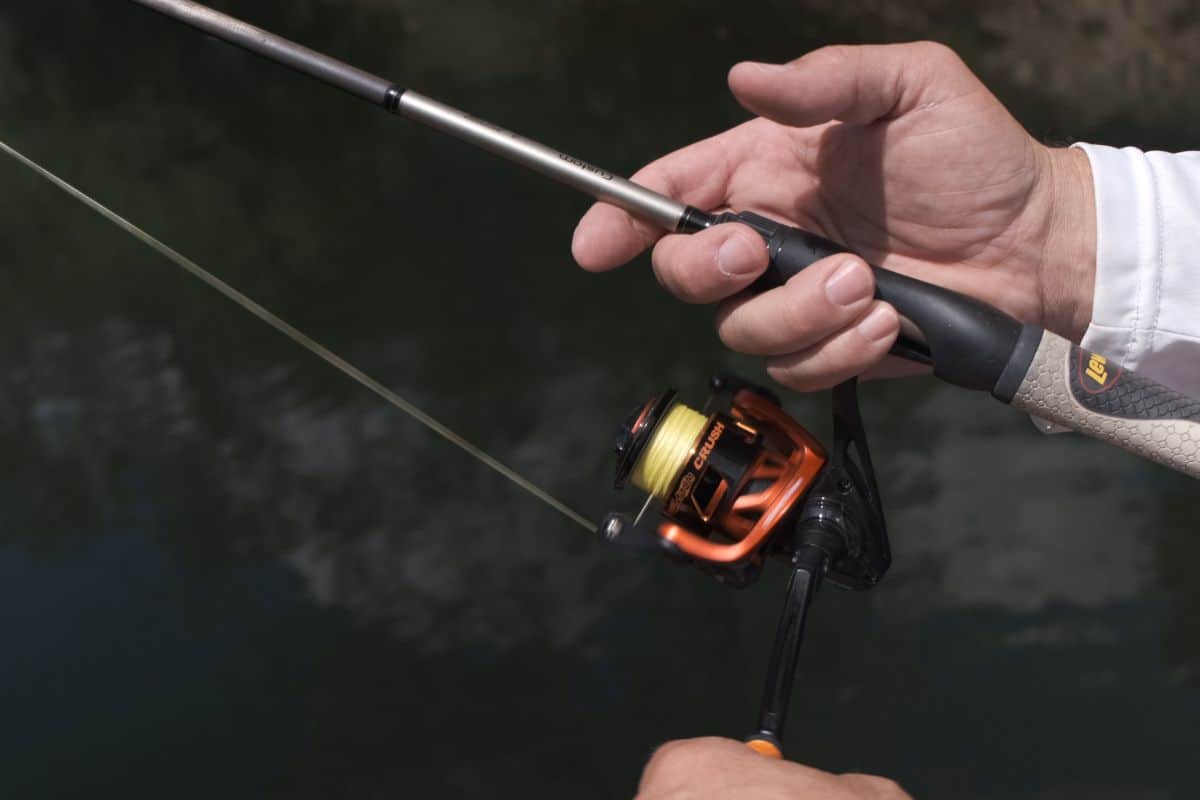Bass fishing can be overwhelming for new anglers. The vast number of lures and techniques with specific rods and reels is a lot to digest.
New bass anglers will have success when fishing the following lures and presentations:
- Wacky Rig
- Texas Rigged Worm
- Topwater Popper
- Small Crankbait
- Drop Shot
The following article will not only discuss each of these lures and presentations but it will also explain how to rig these baits and effective methods for fishing them.
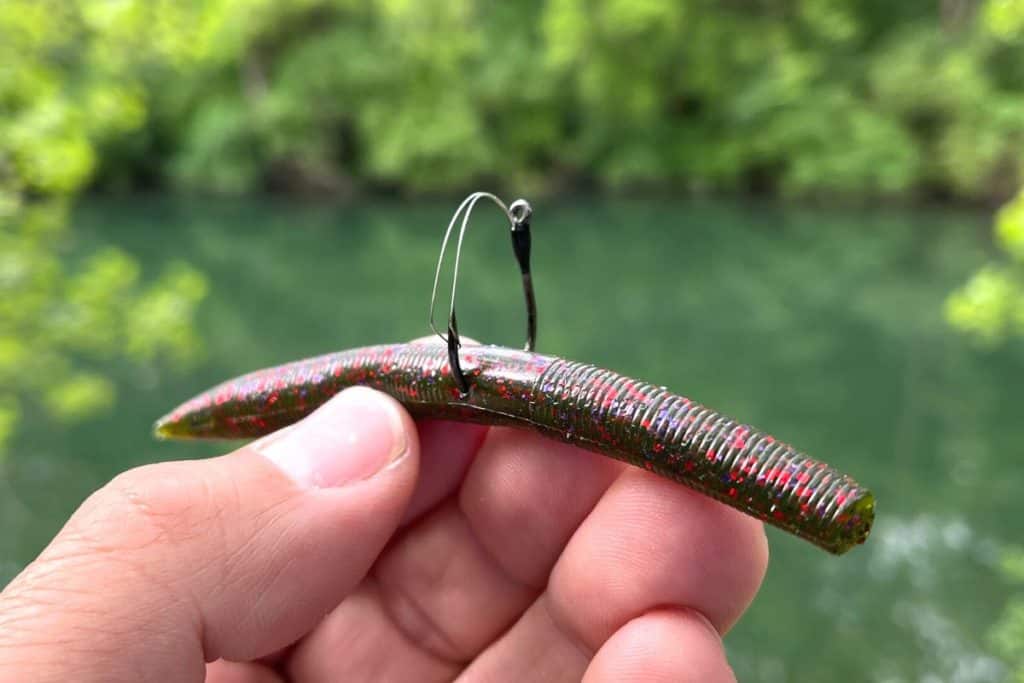
The Wacky Rig is a Beginning Bass Angler’s Best Friend
This time-tested presentation may account for more bass caught in any given year than about anything else you can think of.
Seasoned professionals, youngsters, and new bass anglers all rely on this simple presentation to coax bass into biting – even on the most difficult days.
How to Set Up the Wacky Rig
The lure of choice is a 5” stick bait, commonly referred to by the first one on the market – the Senko.
Stickbaits come in a range of sizes from 3” all the way to big 7” versions, but the standard 5” lure is a great starting point. Its action and profile continually trick bass into eating them.

As far as the hook, there are many that will work, but I like to use a hook designed for wacky rigs. They are smaller or more compact in size. A quick Google search for wacky rig hooks will result in many to choose from.
When fishing waters with a lot of vegetation or wood you may want to buy some weedless, or snagless, versions.
(Here is an article that is a complete guide to wacky rig hook selection.)
Skewer the hook approximately through the middle of the stickbait, like in the image above. The goal is to get the lure to sink in a horizontal manner where each end of the soft plastic shimmies.
Where to Fish a Wacky Rig
My top choice for fishing wacky rigs is around cover or structure that provides shade.
Bass love to get out of the bright sun and things like docks, laydown trees, and weedbeds offer this reprieve.
Cast the lure close to the shade providing cover and let it sink on a slack line. The “slack” is important. If the line is taught, the lure will not drop straight down and almost all the action will vanish.
When the lure hits the bottom leave it sit there for a few seconds. In my underwater filming, I have watched bass come from a distance to observe the lure falling through the water column and then eat it once it is motionless on the bottom.
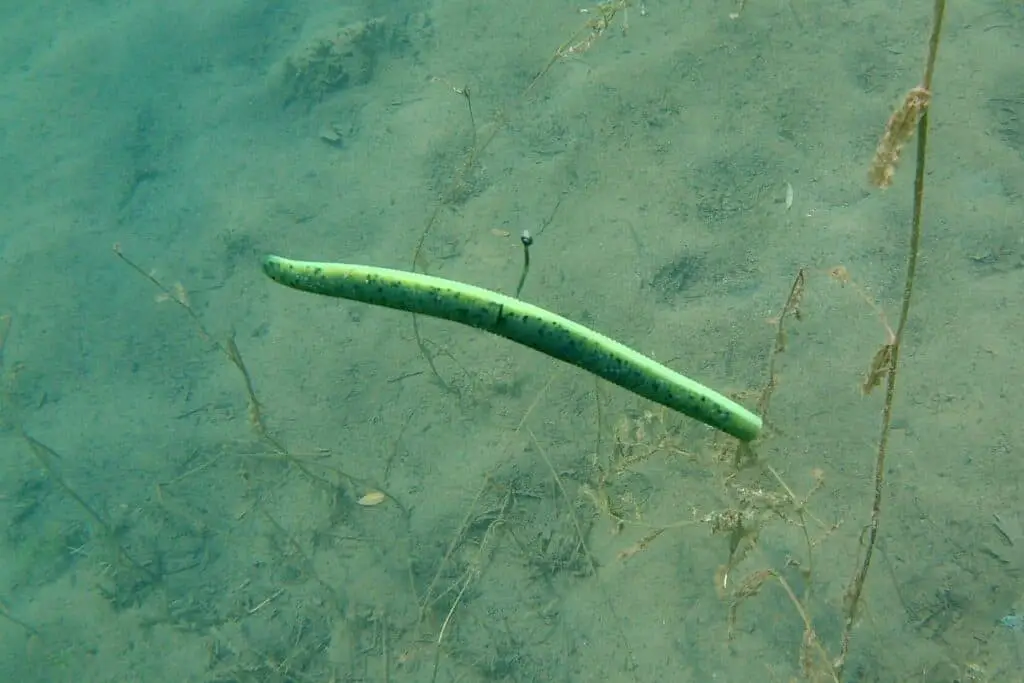
After a few seconds, you can twitch the bait, let it sit, repeat, and then reel it in. It is important to not overwork the lure when you twitch it. Try to imitate lifelike movements. Once again, when filming underwater I have witnessed countless bass swim off scared when the lure is twitched too much.
Be a line watcher as the wacky rig is sinking through the water column. A bass may inhale it on the drop. When this happens it is not uncommon to feel nothing, but the lure will stop sinking before it should. If that is what you suspect, reel down the slack and then set the hook.
Rod, Reel, and Line Setup for Wacky Rig Fishing
For the rod, I like to use a 7’ medium power-rated spinning rod with a fast action. The spinning reel is most often a size 20, or 200, and I use a 20lb braid mainline with an 8-10lb fluorocarbon leader.
For beginning bass anglers though, straight monofilament is going to be fine. Something in the 8-10lb test range will keep the line easier to handle and still provide enough strength to land quality bass.
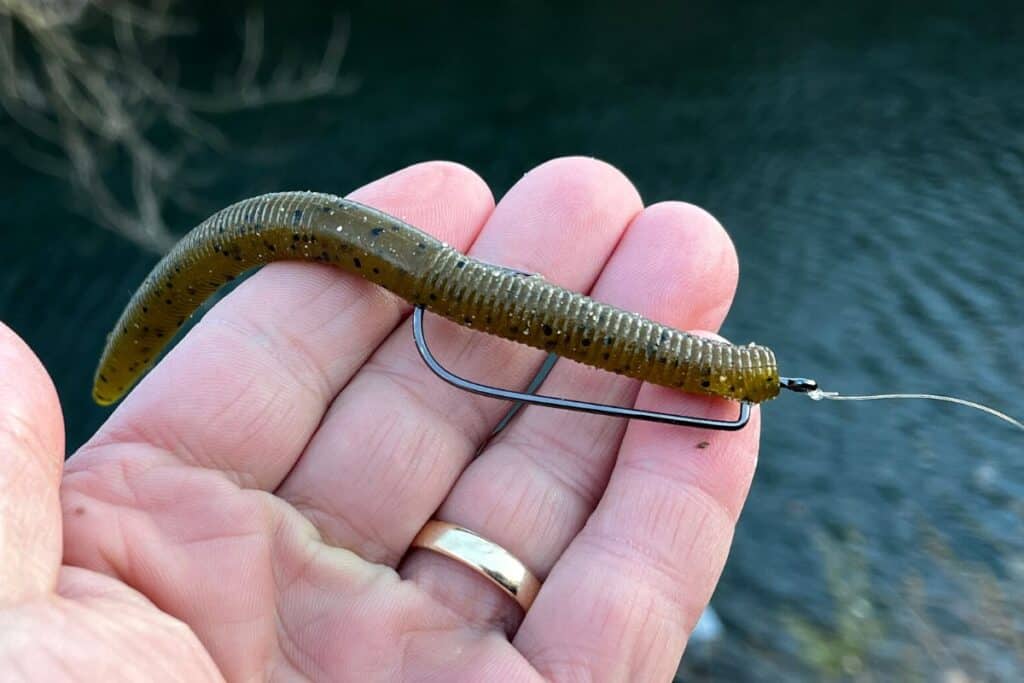
The Texas-Rigged Worm for New Bass Anglers
Bass anglers have been catching their favorite gamefish on plastic worms since 1949. Nick Creme started a revolution in the bass fishing world and the plastic worm is still as effective as it has ever been.
A Texas-rigged worm is easy to fish and new anglers will appreciate the fact the presentation is weedless and about as snag-proof as a lure can get.
How to Set Up a Texas-Rigged Worm
There are many soft plastic worms out there. Enjoy picking some out that you like.
If I were to hand a new angler their first bag of plastic worms, it would be a 7” green pumpkin finesse worm.
The Texas-rig can be fished with a worm weight, or weightless. Most often I use a 1/4oz worm weight to start. If there are lots of shallow weeds in the area I am fishing, then I may also go weightless.
For the hook, an offset worm hook, EWG (Extra-Wide Gap,) and traditional round bend hook will all work. For the 7” finesse worm start off with either a 2/0 or 3/0 model.
The below illustration will demonstrate the rigging process. In the images, I am using a soft plastic creature bait. If you wish to use a worm weight, that needs to be slid up the line before tying on the hook.
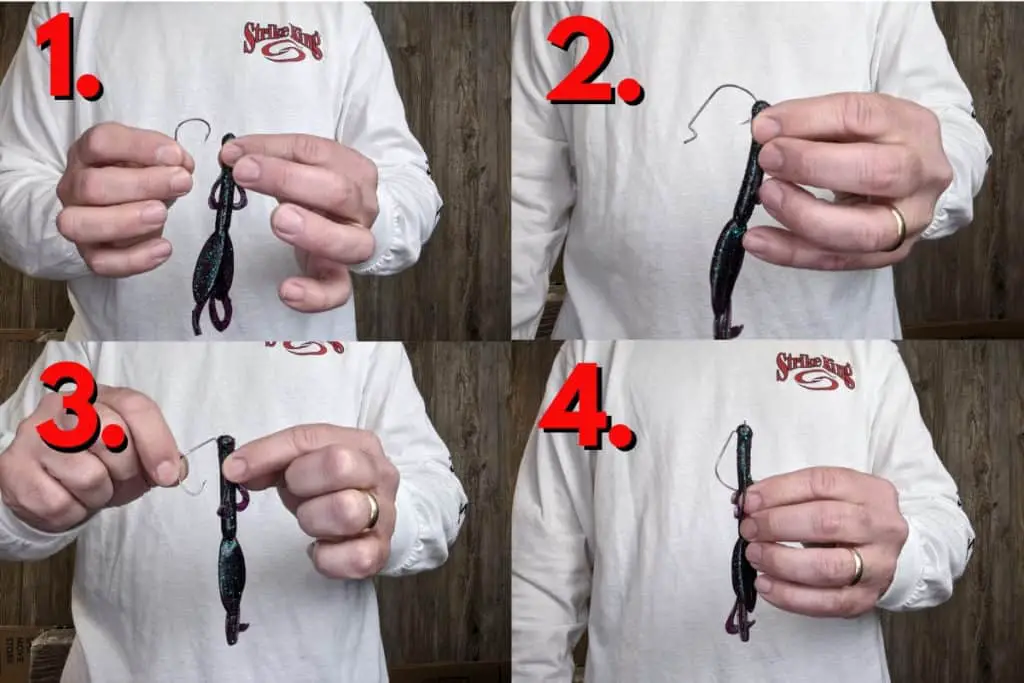
Where to Fish a Texas-Rigged Worm
The beauty of this rig is that it can be fished anywhere. It is designed to work through thick cover like weeds and wood, but it is just as effective crawling along the bottom or swimming up in the water column.
It is hard to fish a Texas-rigged worm wrong, but the most common mistake is to fish it too fast. Slow-and-steady will be the best presentation most times of the year.
Look for edges and start there. This could be the edge of a weedbed, the edges of laydowns, or the edges along the ends of docks. It can even be the edge where shallower water drops into deeper water.
Bass, like most creatures, love to travel along edges, and fishing a worm in those places will keep you in higher percentage areas.
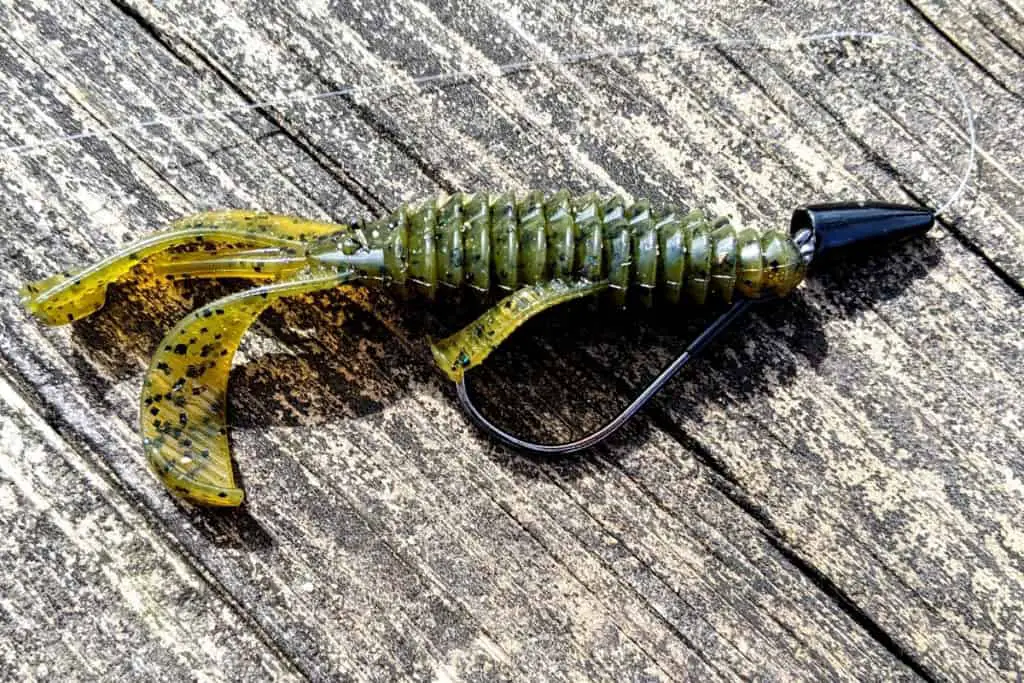
Most bites with a Texas-rig will either feel like a thump or weight. When in doubt, set the hook. Use a strong hookset to help the point of the hook penetrate the lip of the bass.
(Here is an article covering everything you need to know about the Texas-rig.
Rod, Reel, and Line Setup for Texas-Rig Fishing
A Texas-rigged worm is often fished around thicker cover. Therefore, a like to use a rod anywhere from 7’ to 7’4” with a medium-heavy power rating and a fast action. The rod is also going to be a casting model paired with a baitcast reel in the 7.2:1 or 8.5:1 gear ratio range.
But don’t panic. Lots of anglers have tremendous success using spinning gear and if you are a new bass angler, likely this is what you will be using. The stronger power rating will help with hooksets and pulling bass from cover.
I fish straight braid when I can get away with it, or a braid to fluoro leader, but once again if you have monofilament on your spinning gear you will be good. A heavier line will better suit this technique. Something in the 20lb range will be a great starting point.
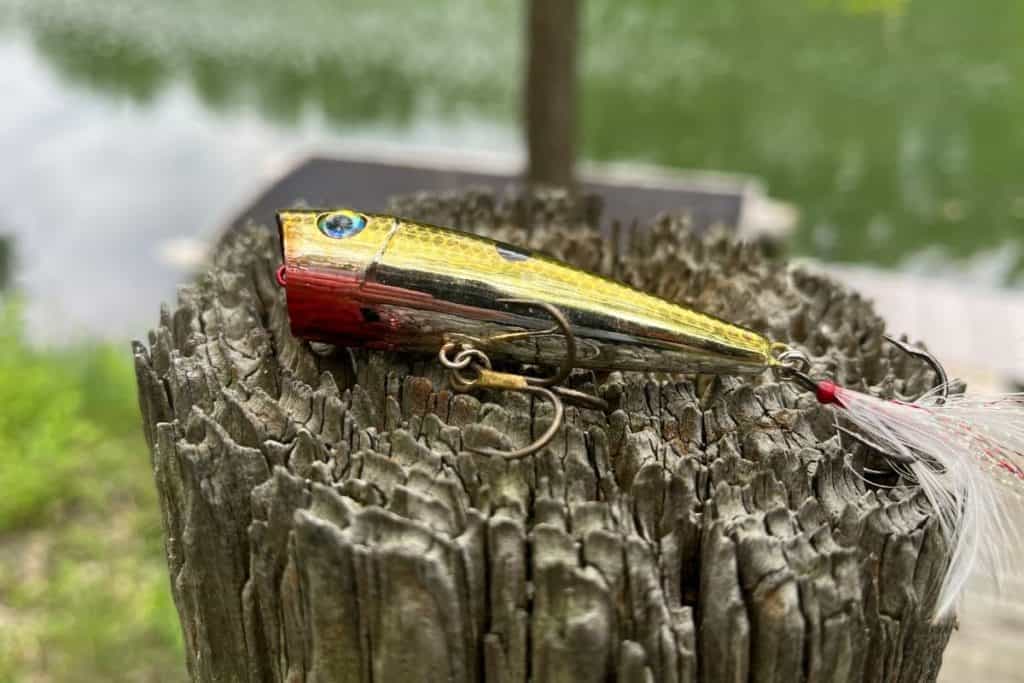
Topwater Poppers are Excellent for Beginning Bass Anglers
Topwater fishing is about as exciting as it gets. The visual explosion of the bass attacking the lure will get your adrenaline pumping and the smiles beaming.
Of all the topwater lures, the traditional popper is the easiest for new bass anglers to use and master.
The rigging is as simple as buying a popper and tying it on. That’s it.
Where to Fish a Topwater Popper
I like to categorize poppers as “coaxing” lures.
These baits do a tremendous job of drawing or pulling bass from cover. A popper mimics something on the surface of the water struggling. This could be baitfish, insects, frogs, or anything else that may find itself in a precarious position.
Bring the popper across submerged weedbeds, along laydowns, next to docks, over rocks, or any other place bass may find protection.
How to Fish a Topwater Popper
Cast the lure out, let it rest a second or two, and then start to twitch the bait back to you.
Experiment with a twitch on a slack line, taught line, small pops, or large ones. Also, vary the cadence. The goal is to draw a first strike and let the bass tell you what they want at that moment.
Then repeat.
(Here is a complete guide on topwater selection.)
Rod, Reel, and Line Setup for Topwater Popper Fishing
Monofilament is a terrific line choice for popper fishing since it floats. It also has stretch to it which can help with compensating for our overzealous hooksets when we see a bass inhale the lure.
Some anglers will opt for straight braid, but you will have plenty of success with mono.
My favorite topwater popper rod is a casting model that has a medium power rating and moderate action. Spinning gear is also an excellent choice for poppers and will allow you to cast these light lures a distance.
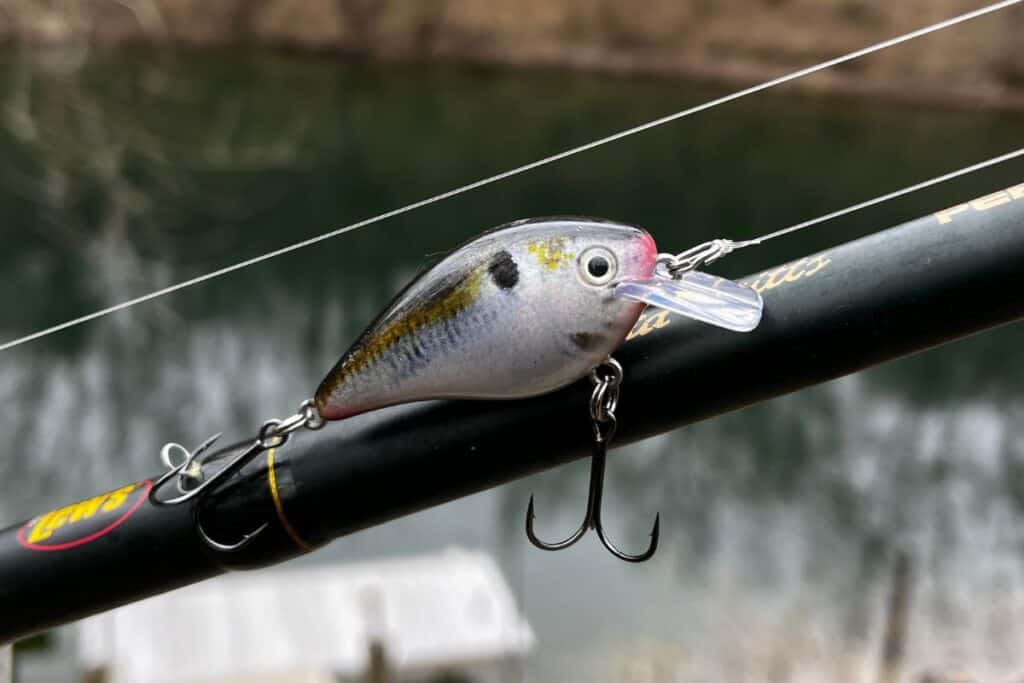
New Anglers Can Catch Lots of Bass with Small Crankbaits
Diminutive crankbaits are not only excellent for catching bass, but they often get bass to reveal where they are.
Tiny cranks are also perfect for shore anglers because they run in shallow water. Many top professionals also rely on small crankbaits to catch numbers of bass and to decipher how many fish are in a given location.
(Here is an article discussing when and where small crankbaits excel.)
Where to Fish Small Crankbaits
Rigging for this lure is as easy as the popper – just tie it on.
One method where these small lures really shine is to parallel a shoreline with them. This keeps the bait in the zone throughout the entire cast.
The goal is to locate where bass are positioned and then make repeated casts to the area. One of the most common mistakes new anglers make is to catch a bass and then move on. If the conditions are such that one bass was comfortable there, odds are others will find it ideal as well.
Like the above-mentioned popper, small crankbaits work well along edges.
Vary the retrieve from burning it back, to starts and stops, and also be confident to let it bounce and deflect off hard cover. Often this deflection will trigger the bass to react and eat the lure.
Rod, Reel, and Line Setup for Small Crankbaits
In a perfect world, anglers will use a true crankbait rod for this presentation, but that is not practical for new bass anglers. Most are probably not aware that rods designed just for crankbaits even exist.
If you are curious though, my ideal crankbait rod is a casting model with a low gear-ratio reel (6.3:1) spooled up with fluorocarbon line. Fluoro is very abrasion-resistant and crankbaits are most effective when running into stuff.
But, mono will work just fine. If you have a spinning rod that is a medium power rating with a moderate action, you will have great success casting and fishing tiny crankbaits.
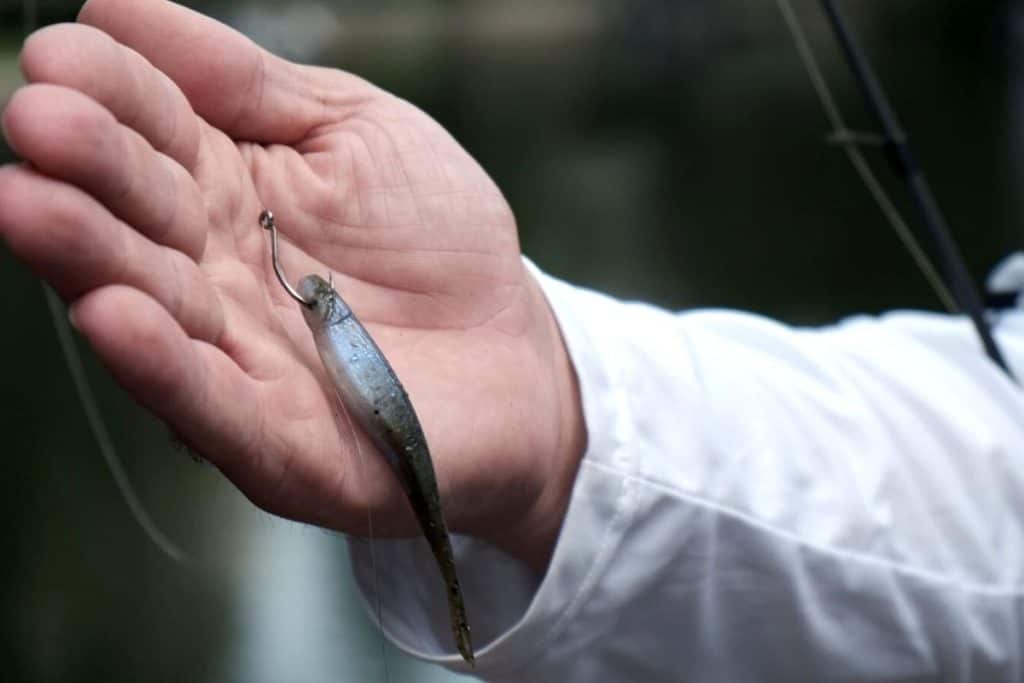
The Drop Shot Rig for New Bass Anglers
I really thought hard about putting this presentation on the list. The learning curve is a little more challenging, but the vast numbers of fish caught with this presentation made it a must-mention.
In fact, more money was won in 2022 by pro anglers on the top three circuits using a drop shot than any other lure or presentation.
(Here is the article discussing the top money lures in 2022)
How to Rig the Drop Shot
The first thing I do is to attach a swivel to my mainline.
This is not a necessity, but the drop shot tends to create a lot of line twist. The swivel eliminates this and makes for a much more pleasant day of fishing.
You can also use a braid to fluorocarbon or mono leader to help eliminate line twist.
Once the swivel is attached to the mainline, I will pull off about an arm’s length of whatever line I am using for my leader. I usually start with 10lb test mono or fluoro.
Tie the hook with a Palomar knot, placing the hook approximately in the middle of the leader length.
Once tied, take a tag end of the leader and run it back through the eye of the hook from the top. This is a simple trick to help hold the hook in an upright position.
The leader that was slipped back through the eye of the hook will now be used to attach the drop shot weight.
Take the other end of the leader line and attach it to the swivel.
(Here is an article that goes into depth about every aspect of rigging a drop shot.)
The lure I prefer to use is the Baby Z Too. The minnow-style bait is neutrally buoyant and catches a lot of bass for me when using this presentation.
Where to Fish the Drop Shot Rig
This technique is best suited for water that is deeper. Being that you are a new bass angler, there is a good chance the majority of your fishing is from the shoreline.
To effectively present the drop shot, you will want to find areas that drop off quickly.
With the weight below the lure, it is important to always visualize that bait working for you 100% of the time. Holding the line still or giving it small twitches will impart nice action to the soft plastic.
This presentation is done most effectively when the line is taught. Therefore, bites are easy to detect.
Rod, Reel, and Line Setup for the Drop Shot Rig
We talked about leader material above, but keep in mind that the mainline can be the same or you can use braid.
Drop shot fishing is best suited for spinning gear with a rod that is a medium or medium-light power rating with an extra-fast action.
Good luck out there and be sure to encourage someone today. You never know how you may change their life forever.
Isaiah 6:8

